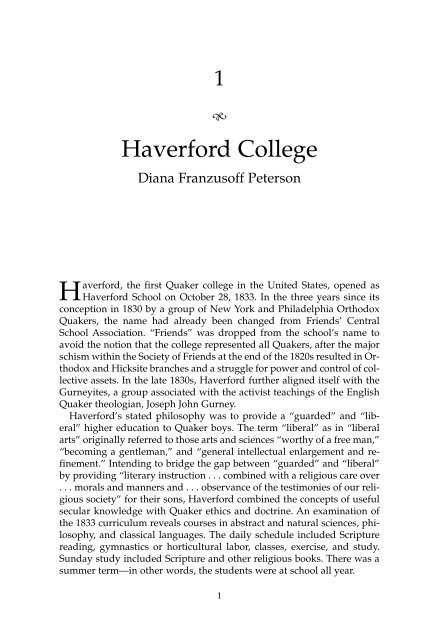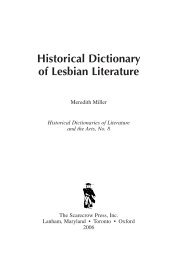- Page 1 and 2: Founded by Friends The Quaker Herit
- Page 3 and 4: Contents Preface v Acknowledgments
- Page 5: Preface Jim Stuckey, an American hi
- Page 9 and 10: Introduction: The Search for the Qu
- Page 11 and 12: Introduction xi joined by many new
- Page 13 and 14: Introduction xiii William Penn (164
- Page 15 and 16: Introduction xv Orthodox Friends em
- Page 17 and 18: Introduction xvii nections were som
- Page 19 and 20: Introduction xix few dormitory stud
- Page 21: Introduction xxi What, then, makes
- Page 25 and 26: Haverford College 3 tendent (a titl
- Page 27 and 28: Haverford College 5 In 1860, presid
- Page 29 and 30: Haverford College 7 the arts, Sharp
- Page 31 and 32: Haverford College 9 monographs, all
- Page 33 and 34: Haverford College 11 fall of 1918,
- Page 35 and 36: Haverford College 13 secretaries. U
- Page 37 and 38: Haverford College 15 In 1961, Hugh
- Page 39 and 40: Haverford College 17 cooperation wi
- Page 41 and 42: Haverford College 19 student at Hav
- Page 43 and 44: 2 Guilford College Gwen Gosney Eri
- Page 45 and 46: Guilford College 23 Jeremiah Hubbar
- Page 47 and 48: Guilford College 25 However, these
- Page 49 and 50: Guilford College 27 In 1865, the wa
- Page 51 and 52: Guilford College 29 The transition
- Page 53 and 54: Guilford College 31 50 to 32 percen
- Page 55 and 56: Guilford College 33 with Five Years
- Page 57 and 58: Guilford College 35 Following the w
- Page 59 and 60: Guilford College 37 vations and reb
- Page 61 and 62: Guilford College 39 bylaws opened b
- Page 63 and 64: Guilford College 41 closely with No
- Page 65 and 66: 3 Earlham College Thomas D. Hamm A
- Page 67 and 68: Earlham College 45 Richmond. By the
- Page 69 and 70: Earlham College 47 His financial su
- Page 71 and 72: Earlham College 49 To be sure, the
- Page 73 and 74:
Earlham College 51 evangelical fait
- Page 75 and 76:
Earlham College 53 from Jones down
- Page 77 and 78:
Earlham College 55 Figure 3.2. Earl
- Page 79 and 80:
4 Swarthmore College Christopher D
- Page 81 and 82:
Swarthmore College 59 Figure 4.1. P
- Page 83 and 84:
Swarthmore College 61 dean of women
- Page 85 and 86:
Swarthmore College 63 Swarthmore Co
- Page 87 and 88:
Swarthmore College 65 graphical bas
- Page 89 and 90:
Swarthmore College 67 and its terri
- Page 91 and 92:
5 Cornell University Elaine D. Eng
- Page 93 and 94:
Cornell University 71 After the bir
- Page 95 and 96:
Cornell University 73 including his
- Page 97 and 98:
Cornell University 75 and Milwaukee
- Page 99 and 100:
Cornell University 77 tion in Febru
- Page 101 and 102:
Cornell University 79 rope, White h
- Page 103 and 104:
Cornell University 81 practical tra
- Page 105 and 106:
Cornell University 83 President and
- Page 107 and 108:
Cornell University 85 Cornell Unive
- Page 109 and 110:
Cornell University 87 Cornell also
- Page 111 and 112:
Cornell University 89 11. Ezra Corn
- Page 113 and 114:
6 Wilmington College Larry Gara ea
- Page 115 and 116:
Wilmington College 93 a number of t
- Page 117 and 118:
Wilmington College 95 The solution
- Page 119 and 120:
Wilmington College 97 versial than
- Page 121 and 122:
Wilmington College 99 attempt to en
- Page 123 and 124:
Wilmington College 101 and its admi
- Page 125 and 126:
Wilmington College 103 derway. Neve
- Page 127 and 128:
Wilmington College 105 barrier fell
- Page 129 and 130:
Wilmington College 107 Several year
- Page 131 and 132:
7 William Penn University John Wag
- Page 133 and 134:
William Penn University 111 the hig
- Page 135 and 136:
Figure 7.1. Lewis Hall Figure 7.2.
- Page 137 and 138:
William Penn University 115 lege’
- Page 139 and 140:
William Penn University 117 WITH TH
- Page 141 and 142:
William Penn University 119 The ath
- Page 143 and 144:
William Penn University 121 an oppo
- Page 145:
William Penn University 123 dent bo
- Page 148 and 149:
126 James Stimpert While living in
- Page 150 and 151:
128 James Stimpert life. George Pea
- Page 152 and 153:
130 James Stimpert steps toward bui
- Page 154 and 155:
132 James Stimpert research, along
- Page 156 and 157:
134 James Stimpert students came ma
- Page 158 and 159:
136 James Stimpert rather an attemp
- Page 160 and 161:
138 James Stimpert in the hospital)
- Page 162 and 163:
140 James Stimpert medical school c
- Page 164 and 165:
142 James Stimpert and political sc
- Page 166 and 167:
144 James Stimpert no one could hav
- Page 168 and 169:
146 James Stimpert 17. Morgan, Wome
- Page 170 and 171:
148 Eric Pumroy of buildings had be
- Page 172 and 173:
150 Eric Pumroy having a self-perpe
- Page 174 and 175:
152 Eric Pumroy Although raised in
- Page 176 and 177:
154 Eric Pumroy would be a means of
- Page 178 and 179:
156 Eric Pumroy Figure 9.2. Bryn Ma
- Page 180 and 181:
158 Eric Pumroy Quaker belief in in
- Page 182 and 183:
160 Eric Pumroy issue of attending
- Page 184 and 185:
162 Eric Pumroy ———. The Powe
- Page 186 and 187:
164 Paul Anderson from 549 undergra
- Page 188 and 189:
166 Paul Anderson 4. Group decision
- Page 190 and 191:
168 Paul Anderson dual preparatory
- Page 192 and 193:
170 Paul Anderson tion of Colleges
- Page 194 and 195:
172 Paul Anderson meet (Beebe, 42).
- Page 196 and 197:
174 Paul Anderson the enrollment mo
- Page 198 and 199:
176 Paul Anderson made the college
- Page 200 and 201:
178 Paul Anderson and cards with th
- Page 202 and 203:
180 Paul Anderson and spiritual for
- Page 204 and 205:
182 Paul Anderson implemented, the
- Page 206 and 207:
184 Paul Anderson reputation, and t
- Page 209 and 210:
11 Whittier College Anne Kiley and
- Page 211 and 212:
Whittier College 189 Figure 11.1. U
- Page 213 and 214:
Whittier College 191 and remains th
- Page 215 and 216:
Whittier College 193 the Whitleaf M
- Page 217 and 218:
Whittier College 195 World War II c
- Page 219 and 220:
Whittier College 197 The curriculum
- Page 221 and 222:
Whittier College 199 Development of
- Page 223:
Whittier College 201 Cooper, Charle
- Page 226 and 227:
204 John W. Oliver Jr. Figure 12.1.
- Page 228 and 229:
Figure 12.2. Walter and Emma B. Mal
- Page 230 and 231:
208 John W. Oliver Jr. Malones in 1
- Page 232 and 233:
210 John W. Oliver Jr. The peace wi
- Page 234 and 235:
212 John W. Oliver Jr. ease with th
- Page 236 and 237:
214 John W. Oliver Jr. who, a gradu
- Page 238 and 239:
216 John W. Oliver Jr. class in rel
- Page 240 and 241:
218 John W. Oliver Jr. Geib, at Mal
- Page 242 and 243:
220 John W. Oliver Jr. inclination
- Page 244 and 245:
222 John W. Oliver Jr. For religiou
- Page 246 and 247:
224 Earl Holmes of worship but lack
- Page 248 and 249:
226 Earl Holmes to never encumber u
- Page 250 and 251:
228 Earl Holmes record of Quakers c
- Page 252 and 253:
230 Earl Holmes criticized for not
- Page 254 and 255:
232 Earl Holmes were soon involved
- Page 256 and 257:
234 Earl Holmes agreed to pay his t
- Page 258 and 259:
236 Earl Holmes Figure 13.1. View o
- Page 260 and 261:
238 Earl Holmes academies closed as
- Page 263 and 264:
14 Azusa Pacific University Sheldo
- Page 265 and 266:
Azusa Pacific University 243 Figure
- Page 267 and 268:
Azusa Pacific University 245 TSCW l
- Page 269 and 270:
Azusa Pacific University 247 time o
- Page 271 and 272:
Azusa Pacific University 249 was so
- Page 273:
Azusa Pacific University 251 FURTHE
- Page 276 and 277:
254 Glenn W. Leppert life, service,
- Page 278 and 279:
256 Glenn W. Leppert located in Hav
- Page 280 and 281:
258 Glenn W. Leppert important, man
- Page 282 and 283:
260 Glenn W. Leppert and the colleg
- Page 284 and 285:
262 Glenn W. Leppert education majo
- Page 287 and 288:
Conclusion John W. Oliver Jr. These
- Page 289 and 290:
Conclusion 267 professors and fello
- Page 291 and 292:
Conclusion 269 school did welcome J
- Page 293 and 294:
Conclusion 271 posal to train a few
- Page 295 and 296:
academic freedom: Bryn Mawr and, 15
- Page 297 and 298:
Carnegie, Andrew, 31 Carnegie Found
- Page 299 and 300:
11, 18; at Hopkins, 130-34, 141, 14
- Page 301 and 302:
Hill, Mary A., 242-43, 243f Hill, M
- Page 303 and 304:
Mendenhall, Orianna, 26 Mendenhall,
- Page 305 and 306:
Cornell, 72-73; Great Migration of,
- Page 307 and 308:
Tyler, John, 76 Tyson, Nathan and M
- Page 309 and 310:
About the Contributors Paul Anderso
- Page 311 and 312:
About the Contributors 289 the majo
















